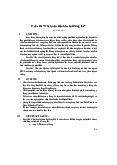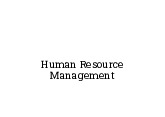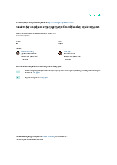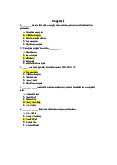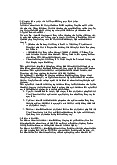



















Preview text:
Chapter1
1. The basic functions of management include all of the following EXCEPT ________. A. staffing B. planning C. organizing D. outsourcing
2. Which individual in an organization is responsible for accomplishing the
organization's goals by planning, organizing, staffing, leading, and controlling personnel? A. manager B. generalist C. marketer D. entrepreneur
3. All of the following are activities performed within the staffing function of
the management process EXCEPT ________. A. evaluating performance B. providing training C. recruiting employees D. maintaining morale
4. ________ is the process of acquiring, training, appraising, and compensating
employees, and attending to their labor relations, health and safety, and fairness concerns. A. Human resource management B. Career planning C. Behavioral management D. Job evaluation
5. In order to enable an organization to compete in the 21st century, human
resource management needs to focus on …….
A. Developing production planning
B. Rationalizing scientific management principles
C. Developing a skillful and flexible workforce
D. Recruiting as many as possible employees
6. Below are the main activities of the HR Department EXCEPT…
A. Directing operations manager
B. Giving services, advice and counseling
C. Developing and implementing organization policy
D. Administer recruitment and training programs
7. The key to quality product and services for an organization depends on how it manages…… A. Budget B. Project C. Labor union strictly D. Employees
8. The HR owned by an organization can be used to compete if the resource is ….. A. Paid special attention B. Well looked after C. Well managed D. Given attractive rewards
9. All of the following are a line manager's responsibilities for effective HR management EXCEPT ________. A. advising upper management B. controlling labor costs C. developing employees D. orienting new employees
10. Which of these is NOT one of the main technological effects towards human resource management?
A. Technology has changed the methods used to gather information of employee transfer
B. Technology has sped up the employee intake data processing
C. Technology has eliminated supervising roles in employee management
D. Technology has improved internal and external communications process
11. Which of the following is NOT considered one of the line supervisor's
responsibilities for effective human resources management under the general headings
outlined by a major company discussed in the textbook?
A. protecting employees' health and physical condition
B. changing employees' attitudes regarding work
C. developing the abilities of each person
D. interpreting the company policies and procedures
12. A line manager's human resource responsibilities most likely include all of the following EXCEPT ________.
A. maintaining department morale B. controlling labor costs
C. protecting employees' health
D. marketing new products and services
13. Which of the following refers to the authority a manager has to advise other managers or employees? A. staff authority B. line authority C. functional authority D. corporate authority
14. In most organizations, human resource managers are categorized as
________, who assist and advise ________ in areas like recruiting, hiring, and compensation.
A. staff managers; line managers
B. line managers; middle managers
C. line managers; staff managers
D. functional managers; staff managers
15. Larry is a line manager at a large sporting goods store. Which of the
following is LEAST likely to be one of Larry's HR responsibilities? A. training new employees
B. interpreting company policies C. sharing financial advice D. disciplining employees Chapter2
1. Which term refers to a procedure for determining the duties and skill
requirements for a specific job and the kind of person most suitable for a position? A) HR management B) job description C) job analysis D) talent management
2. The information resulting from a job analysis is primarily used for writing ________. A) job descriptions B) corporate objectives C) training requirements D) performance standards
3. During a job analysis, a human resources specialist will most likely collect
information about all of the following EXCEPT ________. A) human behaviors B) physical working conditions
C) responsibilities of the position D) employee benefits options
4. Job analysis is most important because managers use it to ________. A) apply talent management B) support all HRM activities
C) comply with ADA requirements
D) provide employment data to the government
5. Maria, an HR manager at ATX Manufacturing, needs to know what sorts of
people to recruit for a process engineering job at the firm. Which of the following
would be most useful for Maria's task? A) job analysis B) organization chart C) industry standards D) performance appraisal
6. What is the first step in conducting a job analysis?
A) developing a job description
B) collecting data on job activities
C) deciding what information to collect
D) selecting representative positions to observe
7. Which of the following would LEAST likely involve the use of job analysis information? A) recruiting decisions B) training requirements C) performance appraisal D) diversification oversight
8. Anna, a new employee at Concord Electronics, wants to make sure she
understands who to report to at the firm and the title of various positions. Which of the
following would most likely help Anna? A) organization chart B) workflow analysis C) process chart D) position analysis
9. Anita, an HR manager, is in the process of conducting a job analysis. She has
just finished selecting a sample of representative positions. What should Anita do next?
A) develop a job description that includes working conditions and responsibilities
B) contact supervisors to verify employees' tasks, responsibilities, and working conditions
C) interview employees to gather information about the job's duties and responsibilities
D) conduct a workflow analysis and develop a diagrammatic process chart for each job
10. What is the final step of the job analysis process? A) creating a process chart B) writing a job description C) determining a sample group
D) verifying data with supervisors Chapter 3
1. ________ is the process of deciding what positions the firm will have to fill and how to fill them. A) Employee selection B) Talent management C) Personnel planning D) Trend analysis
2. What is the purpose of recruiting?
A) forecasting the supply of candidates
B) developing an applicant pool
C) establishing a strategic planl
D) developing qualifications inventories
3. Steve, an HR manager for IBM, must decide what positions the firm should
fill in the next 6 months, which means Steve is currently working on ________. A) candidate screening B) workforce planning C) employee contracting D) department training
4. A firm's ________ should guide employment planning and determine the
types of skills and competencies the firm needs. A) organizational chart B) recruitment process C) marketing plan D) strategic plan
5. Which of the following is LEAST likely to be considered by employers
during the process of workforce planning? A) personnel needs B) organizational culture C) supply of inside candidates
D) supply of outside candidates
6. Which of the following refers to studying variations in a firm's past
employment levels to predict future needs? A) ratio analysis B) trend analysis C) job analysis
7. The process of making forecasts based on the relationship between some
causal factor like sales volume and the number of employees required is called ________. A) ratio analysis B) trend analysis C) graphical analysis D) computer analysis
8. Newton Building Supplies hopes to generate an extra $4 million in sales next
year. A salesperson traditionally generates $800,000 in sales each year. Using ratio
analysis, how many new salespeople should Newton hire? A) 2 B) 5 C) 10 D) 12
9. A ________ shows graphically how two variables are related. A) trend analysis B) ratio analysis C) scatter plot D) correlation analysis
10. ________ contain data on employees' performance records, educational
backgrounds, and promotion recommendations.
A) Computerized forecasting tools B) Replacement charts C) Qualifications inventories D) HR scorecards
11. What is the primary goal of the recruitment and selection process?
A) filling top executive positions
B) forecasting future personnel needs
C) hiring the best candidates for positions
D) increasing the retention of key employees
12. Theresa, an HR manager, works for a firm that is planning to expand
overseas. Theresa is in the process of workforce planning and has already forecasted
the firm's labor demand. What should Theresa do next?
A) create a job competencies matrix of all positions
B) establish training and development plans
C) identify labor supply-demand gaps
D) determine recruitment methods
